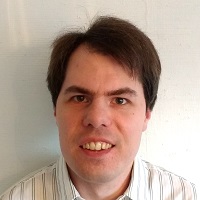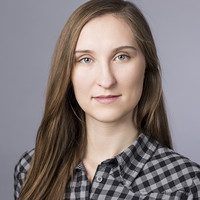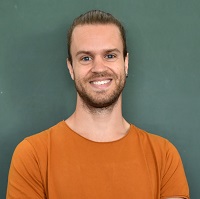Prizes to young researchers
Congratulations to Alexander Edström and Mats Persson for receiving the Göran Gustafsson big prize for young researchers and to Kathlén Kohn, Liam Solus and Maciej Dendzik for receiving the small prize.
Alexander Edström
(Winner of the Large Prize for young researchers - 2.75 Mkr research grant)

How does it feel to receive a Göran Gustafsson Prize for younger researchers?
It’s great to get recognition! Young researchers have to fight through tough competition and are expected to work hard, often without getting too much in return. The prize gives motivation to continue working with determination and confidence in the future.
What is your area of research, and how do you plan to use the funding?
I work in the field of computational materials physics. This means that I solve the basic equations of quantum mechanics to understand and predict the properties of materials. My main interest is in magnetism and magnetic materials. In my recent work, I investigate an exciting new area of research called flexomagnetism, dealing with the effects of curvature, or inhomogeneous deformations, on magnetic materials. In simple terms one might say that I calculate what happens when you bend a magnet. Such deformations are ubiquitous and may be important at the nanoscale. Furthermore, the breaking of symmetries they cause leads to interesting new phenomena. Consequently, understanding these effects is crucial for a complete understanding of nanomaterials. Eventually this understanding will also allow for designing new nanomaterials with desirable functionality.
I am just beginning to explore this new area of research, offering various exiting paths to pursuit. The funding from Göran Gustafssons stiftelse will allow me to continue this work, while also accelerating the pace by hiring a co-worker.
What excites you the most about your area of research?
I work in a field allowing one to contribute to basic research, by understanding and exploring new phenomena in materials. Meanwhile, materials are a key part in every form of technology, whereby clear links can always also be drawn to important applications. Therefore, one may enjoy both the fundamental and applied aspects of scientific research.
In flexomagnetism, I feel that I have been lucky to find an exciting and timely new area of research, which we do not yet know what it will lead to.
Mats Persson
(Winner of the Large Prize for young researchers - 2.75 Mkr research grant)

How does it feel to receive a Göran Gustafsson Prize for younger researchers?
I feel grateful and honored that the Göran Gustafsson foundation has chosen to support my research, and I hope that I will be able to live up to their expectations!
What is your area of research, and how do you plan to use the funding?
My area of research is medical x-ray imaging, specifically x-ray computed tomography. I work with a new type of x-ray detector, a photon-counting detector, which can provide images with higher accuracy and better diagnostic quality than the detectors used today. In my research is centered around the question of how the data from this new detector type can be used to generate the best possible images. I plan to use the prize to fund a PhD student who will develop neural-network based image reconstruction methods for photon-counting image reconstruction. By combining photon-counting CT and deep-learning reconstruction, I hope to develop improved imaging techniques for diagnosing diseases such as cancer, respiratory diseases, cardiovascular disease, and stroke.
What excites you the most about your area of research?
The most exciting thing about medical x-ray imaging is the short distance between basic science and real-world applications. Our work builds on the latest developments in detector hardware and in the mathematics of image reconstruction, and at the same time we collaborate with clinicians to bring the new technology into use in the hospitals in the near future.
www.kth.se/profile/persson6?l=en

Maciej Dendzik
(Winner of the Small Prizes for young researchers - 0.75 Mkr research grant)
How does it feel to receive a Göran Gustafsson Prize for younger researchers?
It feels great. I'm very happy and honored to be among the Göran Gustafssons Prize winners. Also, I'm grateful to the foundation for supporting young researchers.
What is your area of research, and how do you plan to use the funding?
My area of expertise lies between two-dimensional materials and photonics. Properties of a material thinned down to just a single atomic layer can be much different from its bulk parent due to quantum confinement. We investigate electronic properties of 2D materials using time-resolved photoemission. This technique enables us to look at the ultrafast excited carriers dynamics on a femtosecond timescale. In the future, I would like to investigate a possibility of inducing phase transitions using tailored light pulses by destabilizing bonds or inducing certain atomic motions using terahertz radiation. The funding from Göran Gustafssons Foundation will help me to establish a research group oriented around this topic.
What excites you the most about your area of research?
I'm very excited about the idea of manipulation of matter with light. Such studies require very strong light fields which wasn't, up until recently, possible to achieve. Developments of laser technology and terahertz radiation generation have opened up a vast and largely unexplored territory for investigations of basics physics under quite extreme conditions. Light can be used to induce dynamically-stable exotic phases or to quench a system in meta-stable states due to ultrafast energy transfer. Furthermore, I can imagine future opto-electronic devices being patterned out of 2D materials using light beam.
Kathlén Kohn
(Winner of the Small Prizes for young researchers - 0.75 Mkr research grant)

How does it feel to receive a Göran Gustafsson Prize for younger researchers?
I am of course very happy! This is my first Swedish prize. I moved here 1.5 years ago and now the prize will help me to increase my local visibility. Receiving the Göran Gustafsson Prize for younger researchers is a great acknowledgment of both my research field and my contribution to it.
What is your area of research, and how do you plan to use the funding?
My research area is nonlinear algebra. This is essentially algebraic geometry, but with a focus on applications. I am mainly interested in applications within data science and AI. More specifically, I study the algebraic and geometric structures underlying statistical models and optimization problems, machine learning, and the reconstructions of 3d scenes in computer vision.
I plan to use the prize money to enlarge my team.
What excites you the most about your area of research?
My excitement is twofold. On the one hand, historically algebraic geometry has not been part of applied mathematics for a long time, but now there is a growing, thriving, very open-minded, and diverse community of non-linear algebraists. I am very happy to be a part of this exciting development. On the other hand, there is a lot of experimental and practical knowledge in data science and AI, whereas the theory still has to catch up. My belief is that to achieve this, many areas of mathematics have to join forces, and I am certain that nonlinear algebra will play a central role in that development.
Liam Solus
(Winner of the Small Prizes for young researchers - 0.75 Mkr research grant)

How does it feel to receive a Göran Gustafsson Prize for younger researchers?
It is a really wonderful surprise! The Göran Gustafsson Prize for younger researchers is certainly a prestigious award, but going further, it is also a powerful reminder that the Swedish mathematics community supports my research endeavors. Receiving this prize only made me more motivated to continue my work and produce new and interesting insights to share with Sweden and the rest of the world.
What is your area of research, and how do you plan to use the funding?
My research is in combinatorics (or discrete mathematics) and its applications to areas such as statistics, artificial intelligence, algebra, and geometry. Combinatorics as a field centers itself around the study of combinatorial objects, such as networks (graphs), permutations, or even high-dimensional generalizations of polygons (called polytopes). As many students at KTH learn in our basic courses on discrete mathematics, such objects have numerous connections and applications to fields including algebra, geometry, topology, and even statistics and probability. In recent years, most of my research has centered around problems where the goal is to describe important features of some probability distribution that is naturally associated to one of these combinatorial objects. A popular example of such a problem arising in artificial intelligence is when we have data on the occurrences of a family of events, and we would like to learn a network (a combinatorial object) that best describes the underlying cause-effect relationships between the events based on the data. Here, the data-generating distribution is inherently tied to the structure of the unknown causal network, and our goal is to use properties of the possible networks to accurately and efficiently learn the true network based on our data. While such problems are naturally linked to the subfield of combinatorics called graph theory, new advances have shown that we can exploit connections to geometry and algebra to produce increasingly better results. For instance, some of our newest methods use one geometric combinatorial object (such as a polytope) to learn another combinatorial object (like a causal network) that best encodes the desired feature of the data-generating distribution. On the other hand, questions about important features of probability distributions also arise directly within fields such as algebra, geometry and topology. In these fields, the distributions of interest are often treated as the coefficients of some polynomials, and they encode important information about hard-to-visualize geometric objects. For such problems, we are using associated combinatorial objects to prove theorems about the roots of these polynomials that provide the algebraists and topologists with useful information about the distributions they encode, and in turn, about the associated geometric objects.
My plan is to use the prize to hire a new postdoc for our group at KTH. The problems I like to study are quite interdisciplinary, so I always love having a large group of people with diverse backgrounds who are excited about working together, combining expertise, and learning from one another. I am a member of the new division of Mathematics for Data and AI in the Department of Mathematics at KTH, where we are working to foster such interdisciplinary collaborations at the interface of theoretical mathematics and artificial intelligence. Thanks to support of the Wallenberg Autonomous Systems and Software Program (WASP) and the Brummer and Partners MathDataLab, we have already been able to hire a number postdoctoral researchers and PhD students with expertise spanning from statistics, causality and AI to algebra, combinatorics and topology. Thanks to the Göran Gustafsson Prize, I will be able to hire another researcher who can help foster interdisciplinary research in these areas. My plan is to see how the group evolves over the next few months, and then put out a call for a postdoc in an area that will best complement and support the group's research efforts.
What excites you the most about your area of research?
There are many things that excite me about my research, but I will limit myself to two answers: a humanist one and a scientific one. First, the interdisciplinary nature of my research requires that I interact with, and promote interaction between, many different researchers with a variety of different interests. I have always loved learning about new areas of mathematics, and I feel that interacting with others is the best way to do so. I try and promote active and inclusive discussions because I believe it helps interdisciplinary fields of mathematics achieve great things. I also believe that the need for inclusivity with respect to different areas of scientific expertise in interdisciplinary fields encourages a mindset for inclusivity on a sociological level, opening doors to a more diverse and accepting mathematics community. These social aspects of my research are really exciting for me. As for the scientific answer, I am most excited when I get to work on problems that start in one end of a traditionally divided spectrum - either in very abstract mathematics or very applied mathematics - and then work their way all the way to the other end. For instance, some projects we have been working on lately take ideas from statistics and causality as motivation for new results in algebraic geometry, which in turn motivate new algorithms for causality that we even end up applying to real data. This exchange of ideas between the pure and applied fields in new and creative ways is extremely exciting for me.
